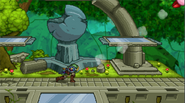
|
This article may require some new images.
Whether it is a new image or simply a higher quality update, upload the new file and add it into the article. Remember to always upload an updated file under the same name as the older version to supersede it. |
Knockback is the distance a character flies when the character is hit by an attack. It is measured in pps, or pixels per second. For example, Mario's fully charged forward smash does 9 pps of forward knockback to an opponents Mario at 0% damage. A player can avoid receiving knockback by dodging or using an attack that gives invincibility frames or knockback resistance.
Notably, in SSF2 Beta, the audience seems to replace the "Deadly Blow" effect found in Super Smash Bros. 4: if the audience cheers on an attack it will most likely KO.
Conditions
This is a list of conditions the knockback of an attack depends on:
- Current % damage of the victim.
- Weight and Gravity of the victim.
- The staleness of the move used.
- The Damage Ratio. The Damage Ratio is the multiplication of the knockback.
Knockback values
Each hitbox of a move has two knockback values: a base knockback and a knockback scaling (also known as knockback growth). Base knockback is the minimum amount of knockback that an attack can deliver (in normal circumstances), and knockback scaling is a factor that controls how much knockback increases as damage increases. Moves with high base knockback deal high knockback under any circumstances, such as the swing of the Home-Run Bat. They additionally tend to be more effective at KOing when less knockback is needed (ex. light characters who are near the ledge or when an opponent is handicapped to sustain more knockback). On the other hand, moves with high knockback scaling take less damage to reach KO potential, such as Bomberman's forward smash. They additionally tend to be more effective at KOing when the opponent requires more knockback to be KO'd (such as against heavier characters, when far away from a stage's blast line, or when an opponent is handicapped to sustain less knockback). Techniques such as Directional Influence and Momentum canceling who help extend a players survival becomes less effective the stronger an attack's knockback scaling is.
Set knockback
Set knockback, sometimes referred to fixed knockback, is a property of some attacks where the knockback dealt by the attack is static. As such, it does not depend on the opponent's percentage. Some moves also deal set knockback based on a character's weight, called weight knockback.
List of set knockback attacks

|
This article is incomplete.
Though it is not necessarily short, it is still missing some vital information and urgently requires it. You can help the McLeodGaming Wiki by filling in the blanks. |
- Many standard attacks.
- Bandana Dee's neutral aerial and forward aerial (weak hits).
- Bowser's down aerial.
- Captain Falcon's up smash (first hit).
- Chibi-Robo's forward smash (weak hits), and up smash (first hit).
- Fox's up aerial (first hit) and Reflector.
- Ichigo's down smash (multi-hits)
- Kirby's dash attack (weak hits), down aerial, and Inhale.
- Lloyd's down aerial (weak hits).
- Luigi's up throw.
- Mario's down aerial, and Cape.
- Naruto's Shadow Clone Slash.
- PAC-MAN's up throw.
- Pikachu's forward aerial (weak hits), and Quick Attack.
- Samus' forward aerial and up aerial (weak hits), and forward smash (first hit).
- Sandbag's up smash (first hit).
- Sora's up smash and down smash (weak hits).
- Sonic's up aerial (first hit), and Spin Dash.
- Wario's down smash, and Chomp.
- Zelda's up smash (weak hits).
No knockback
No knockback, as the name says, are attacks that do damage, but deal zero knockback. These attacks are normally used to damage the opponent without making them flinch, but the opponent is still able to move freely while they are being attacked.
List of no knockback attacks
- Fox's Blaster.
- Mega Man's Mega Buster (level 1, late hit).
One-Hit KO
Main article: One-hit KO
A One-Hit KO, also known as a OHKO, is an attack that can KO a character at 0% damage.
Formula
The knockback formula used in Super Smash Flash 2 is the same one used in Brawl and Melee. However, due to the two games having a different coordinate space, the devs have to scale things differently.
Melee/Brawl formula.
The formula that affects the vertical knockback.
Variables
- p is the percentage of the target, counted after the attack's damage is added.
- d is the damage the attack dealt.
- w is the weight of the target.
- s is the attack's knockback scaling (also known as knockback growth) divided by 100 (so a scaling of 110 is input as 1.1).
- b is the attack's base knockback.
- r is a ratio based on a number of factors, including:
- Difficulty
- Handicap
- Smash charge interruption bonus
If the move has a weight-based knockback value set (so the move deals set knockback), then d is set to that value, and p is always 10.


